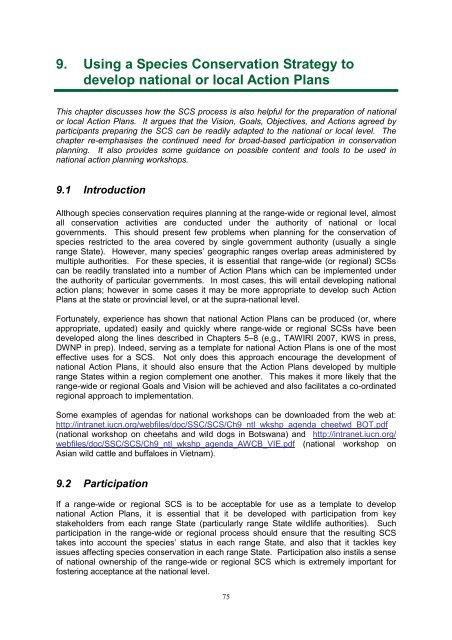Strategic Planning for Species Conservation: A Handbook - IUCN
Strategic Planning for Species Conservation: A Handbook - IUCN
Strategic Planning for Species Conservation: A Handbook - IUCN
You also want an ePaper? Increase the reach of your titles
YUMPU automatically turns print PDFs into web optimized ePapers that Google loves.
9. Using a <strong>Species</strong> <strong>Conservation</strong> Strategy to<br />
develop national or local Action Plans<br />
This chapter discusses how the SCS process is also helpful <strong>for</strong> the preparation of national<br />
or local Action Plans. It argues that the Vision, Goals, Objectives, and Actions agreed by<br />
participants preparing the SCS can be readily adapted to the national or local level. The<br />
chapter re-emphasises the continued need <strong>for</strong> broad-based participation in conservation<br />
planning. It also provides some guidance on possible content and tools to be used in<br />
national action planning workshops.<br />
9.1 Introduction<br />
Although species conservation requires planning at the range-wide or regional level, almost<br />
all conservation activities are conducted under the authority of national or local<br />
governments. This should present few problems when planning <strong>for</strong> the conservation of<br />
species restricted to the area covered by single government authority (usually a single<br />
range State). However, many species’ geographic ranges overlap areas administered by<br />
multiple authorities. For these species, it is essential that range-wide (or regional) SCSs<br />
can be readily translated into a number of Action Plans which can be implemented under<br />
the authority of particular governments. In most cases, this will entail developing national<br />
action plans; however in some cases it may be more appropriate to develop such Action<br />
Plans at the state or provincial level, or at the supra-national level.<br />
Fortunately, experience has shown that national Action Plans can be produced (or, where<br />
appropriate, updated) easily and quickly where range-wide or regional SCSs have been<br />
developed along the lines described in Chapters 5–8 (e.g., TAWIRI 2007, KWS in press,<br />
DWNP in prep). Indeed, serving as a template <strong>for</strong> national Action Plans is one of the most<br />
effective uses <strong>for</strong> a SCS. Not only does this approach encourage the development of<br />
national Action Plans, it should also ensure that the Action Plans developed by multiple<br />
range States within a region complement one another. This makes it more likely that the<br />
range-wide or regional Goals and Vision will be achieved and also facilitates a co-ordinated<br />
regional approach to implementation.<br />
Some examples of agendas <strong>for</strong> national workshops can be downloaded from the web at:<br />
http://intranet.iucn.org/webfiles/doc/SSC/SCS/Ch9_ntl_wkshp_agenda_cheetwd_BOT.pdf<br />
(national workshop on cheetahs and wild dogs in Botswana) and http://intranet.iucn.org/<br />
webfiles/doc/SSC/SCS/Ch9_ntl_wkshp_agenda_AWCB_VIE.pdf (national workshop on<br />
Asian wild cattle and buffaloes in Vietnam).<br />
9.2 Participation<br />
If a range-wide or regional SCS is to be acceptable <strong>for</strong> use as a template to develop<br />
national Action Plans, it is essential that it be developed with participation from key<br />
stakeholders from each range State (particularly range State wildlife authorities). Such<br />
participation in the range-wide or regional process should ensure that the resulting SCS<br />
takes into account the species’ status in each range State, and also that it tackles key<br />
issues affecting species conservation in each range State. Participation also instils a sense<br />
of national ownership of the range-wide or regional SCS which is extremely important <strong>for</strong><br />
fostering acceptance at the national level.<br />
75

















